Why am I sensing hyperventilating, hopping-up-and-down excitement levels about Spike Lee signing to direct an Oldboy remake? Sounds like a very good thing, okay, but don’t have a cow about it. The big news will be the casting of the lead.
Zoo
I’m sorry but the atmosphere inside the once-exclusive and high-toned Beverly Wilshire hotel, which I visited last weekend, is like that of a shopping mall in Riyadh. Like much of Beverly Hills itself, it’s been overrun by nouveau-riche Middle Eastern families. They’re staying there for the social-statement and luxury factors, of course, but their presence, no offense, seems to de-luxurize the place.
Groups of loudly chattering women in black hijabs, rich kids running around in loud T-shirts, overdressed Eurotrash guys in their 30s with cream-colored suits with bling and tall blonde trophy girlfriends, Baby Huey-sized Arab tweens and teens hanging out in basketball shorts and sneakers, sleazy-sounding disco music emanating from the first-floor bar, etc.
It’s quite a different establishment than it was in the ’90s, let alone the ’70s or ’80s. I used to walk into the Beverly Wilshire lobby and say to myself, “Ah, yes…a touch of class. A hushed sense of refinement. Only the best people.” No longer.
Cutting Out
My flight to San Francisco and the Dolby Surround 7.1 hoo-hah event leaves from Burbank at 1:45 pm, so that’s it for now. For the first (and probably only) time in my life I’ll be staying at the Mark Hopkins hotel on Nob Hill, which was used as a setting in Bullitt and Kiss Them For Me and (I think) two or three other films. Question to publicist: “Does the Hopkins have a shuttle from SFO to the city? Or should I take a BART train?” Publicist: “Take a cab.”
Sigh of Relief
The last and final Harry Potter film, as I noted in yesterday’s review, concludes the franchise on a note of high absorption and respectability. Good for that. I’m posting this 7.8 assemblage because one of the most affecting moments in Deathly Hallows 2 is a shot of Daniel Radcliffe‘s Harry at age 11 (or whatever he was when the series began production a little more than ten years ago). At the time he seemed nine or ten, at most.
"You're Done!"
It’s rare for a LQTM type like myself to laugh out loud, but N.Y. Post film critic Kyle Smith‘s 7.8 account of his dealings with Virginia-based publicists Keith Appell and Peter Robbio (whose firm, Creative Response Concepts, is conservative-friendly) provided an exception. Robbio-Appell didn’t allow Smith to attend a press screening of The Undefeated, the pro-Sarah Palin doc, because they’d invited his colleague, Lou Lumenick, and not Smith. Important distinction!
“What’s hilarious about all this is that Lou, who probably had a George McGovern bumper sticker on his lunchbox in college, is far less likely than I, a sensible conservative, am to see the wisdom in a Palin-praising documentary,” Smith wrote.
Pesci Snickers
This is almost two months old but I hadn’t seen it until this morning. Decent, mildly funny, etc. The thought of eating a Snickers bar right now is moderately repugnant. I have a vivid high-school memory of kissing a girl who’d just eaten a Snickers bar (or maybe a Mars bar) and suffering from serious olfactory blowback. Almond Joy, on the other hand, was never a problem.
More Trujillo!
A mere two days after coming upon a 1958 Los Angeles Times front-page headline informing that Zsa-Zsa Gabor had admitted accepting a $17,000 fur coat from Ramfis Trujillo, the Uday Hussein-like son of the Dominican Republic dictator Rafael Trujillo, I discovered a website showcasing 1950s-era covers of Whisper magazine, apparently a slimier, runtier version of Confidential, and a November 1958 story riffing on Trujillo, Gabor and Kim Novak, whom the dictator’s son also allegedly “knew”, so to speak.
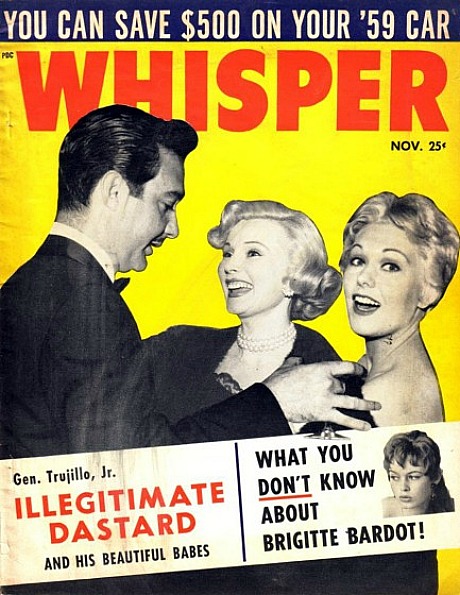
I wasn’t looking for Ramfis Trujillo material, mind. His Zsa-Zsa connection was a secondary headline — a glancing peripheral — alongside the Peter Lawford broken-arm story I satirized the other day. But he turned up again this morning nonetheless.
Shawn Levy‘s biography of Porfirio Rubirosa, “The Last Playboy,” is “filled with Trujillo stories, including a lengthy chapter about the Ramfis/Zsa Zsa/Kim Novak affairs,” Levy informs. Also: a history of Confidential and other magazines takes up most of a chapter.”
The Pulp International summary partially reads as follows:
“Could one of the most brutal killers in the world openly hobnob with the Hollywood set today? We doubt it. But back in the day, a few rumors of murder only bolstered a man’s adventurous reputation, as proved by this November 1958 Whisper showing Rafael ‘Ramfis’ Trujillo, Jr. charming Zsa Zsa Gabor and Kim Novak. One or both women, you may notice, actually appear courtesy an X-acto knife and glue, but what self-respecting tabloid has time to locate a legit photo when paste-up will do the job almost as well? Trujillo did date and bed both Gabor and Novak in real life, which makes this cover technically accurate, and makes him the second most enviable Dominican jet-setter in history.
“Ramfis Trujillo reportedly gave most women that frisson some find irresistible, but his life wasn’t all starlets and champagne. Though he wanted nothing more than to be a playboy, there was an obstacle in the form of family baggage. Specifically, his father was a sadistic military dictator who had been put in power in the Dominican Republic by the CIA. Trujillo, Sr. expected his son to continue in the family business. This had been abundantly clear to Ramfis since the day his father made him a full general — with full pay — at age nine. For this and other reasons, he grew up with a warped sense of power and, by the time of this Whisper cover, had already ordered several murders and indulged in the occasional gang rape.
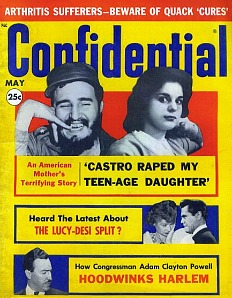
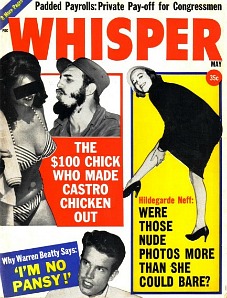
“He might have been considered a classic chip-off-the-old-block, save for rumors that Ramfis’s father was actually a Cuban named Rafael Dominicis — hence the “illegitimate dastard” tag in the banner. But the story about Ramfis being illegitimate was strongly denied by everyone involved (except Dominicis, who ‘disappeared’).
“In any case, through the late 50s Ramfis tomcatted his way from Hollywood to Paris, and only occasionally let his urbane manner slip to reveal someone considerably less charming beneath. He seemed to have settled into his chosen lifestyle permanently when he married an actress named Lita Milan, below, who had starred opposite Paul Newman in The Left-Handed Gun.
“But back in the Dominican, the impulsive Rafael Trujillo, Sr. was behaving less and less like the good lapdog the CIA had put in charge three decades earlier. Eventually, his U.S. benefactors turned against him and he died in a fusillade of possibly CIA-arranged bullets.
“Junior succumbed to the pull of familial duty, as well as the desire for revenge, and flew back to the Dominican to restore order. This involved personally killing some of the participants in his father’s assassination. While this must have given him great satisfaction, it did little to stabilize the country. Under pressure from both internal enemies and the U.S., Ramfis Trujillo fled to Spain less than a year later with a casket containing millions in cash, jewels, bonds, and his father. By 1969 Jnior was dead too, due to complications stemming from an automobile accident in Madrid.
“In the end Ramfis Trujillo presents an interesting question of nature versus nurture — was he meant to be a ladykiller, a real killer, or both?”
For Some Reason…
This line, spoken in a film I was half-watching an hour ago, sunk in: “Whereever there is greatness, great government or power, even great feeling or compassion, error also is great. We progress and mature by folly. Perfect freedom has no existence. The grown man knows the world he lives in.”
Hogwarts Reduced to Rubble
It’s mildly pleasing on some level to report that Harry Potter and the Deathly Hallows, Part 2 (Warner Bros., 7.15), which I saw this morning, is a tightly-scripted, action-heavy, relatively satisfying finale to a franchise that, for me, had worn out its welcome many years ago. When it ended I didn’t just say, “Well, that‘s finally over!” I also said to myself, “Not half bad.”
I wasn’t exactly tingling with pleasure, being a confirmed Potter-franchise hater and all, but neither was I scowling or groaning or taking e-mail breaks. It’s quite all right for what it is. Okay, maybe even better than all right. I was actually following what was going on and being said, which is saying something for easily distracted (and frankly bored-from-the- get-go) me. But there really is something to be said for finally tying together loose ends and being done with the damn thing already.
And the epilogue, which is set 19 years after final mano e mano showdown at Hogwarts between Harry and Ralph Fiennes‘ Lord Mumblecore Elsinore whatevermore Voldemoort, is genuinely nice and sweet and satisfying. It puts an agreeable ribbon on it. Hollywood Reporter critic Todd McCarthy was exactly and precisely right when he said “it ends well.”
Let’s let it go at that. Nobody wants to hear from a hater who’s been suffering from this franchise for the last several years and is now in a forgiving…well, an eased-up frame of mind.
I have one complaint and one observation that no other film critic, I suspect, will bring up. It is profoundly displeasing to see Hermione (Emma Watson) and Ron Weasley (Rupert Grint) end up as romantic lovers and then as husband-and-wife with kids. Hermione deserves better and can do better. She’s too cool, too spirited and too alluring to end up with a red-haired, freckle-faced second-rater who’s been whining and shivering with terror in the face of each and every threat in every Harry Potter film from the beginning. A hot and brave lady should end up with a brave and strapping lad who’s earned her favors, i.e., not Grint.
On top of which Grint is becoming a bit of a pudgebod, and he’s only 22 now — 21 when the final film was shot. He’s developing a bit of a belly and the beginnings of a Uriah Heep look. It’s easy to imagine him having a kind of Shrek-like appearance by the time he’s 28 or 30. I don’t know if he’s been drinking along with Daniel Radcliffe but he’s clearly been leading a dissolute life.
Hitler vs. 405 Shutdown
Most of the dreaded 405 freeway, a nightmare under normal conditions except in the wee hours, will be closed for 53 hours next weekend between the 10 freeway and the 101. The shutdown will begin late Friday evening, 7.15, and end at dawn on Monday, 7.18. Leave town or stay indoors or go into a coma, but forget driving to or from LAX on the 405 or going to the Valley for any reason, because north-south canyon traffic is going to be well beyond description.
Spencer's Moment
I had a brief, enjoyable chat with the radiant Octavia Spencer (a.k.a. “Minny“) at last night’s press gathering for The Help (Touchstone, 8.10) at the Beverly Wilshire. Tate Taylor‘s period drama might have seemed like a liberal do-good fable to some were it not for Spencer’s level-straight performance as an African-American maid with a fully justifiable chip on her shoulder. (And for the equally formidable performance of costar Viola Davis, who didn’t attend last night’s event.)
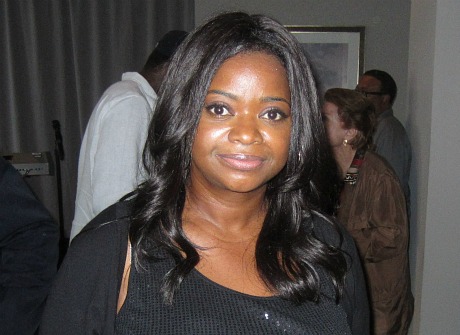
The Help star Octavia Spencer — Saturday, 7.9, 8:05 pm, Beverly Wilshire hotel.
Best known for her comedic acting (and particularly for her ongoing role as Constance in Ugly Betty), Spencer has been working it since the mid ’90s. Her first feature role was in Joel Schumacher‘s A Time to Kill (’96). As far as I can tell her performance in The Help is Spencer’s first major dramatic lead in a feature. “An overnight success after 17 years,” is how she laughingly put it last night.
Octavia is a very serene presence and a good-natured pro. As I was chatting with her a tall blonde Valkyrie whom she didn’t know seized her, passionately hugged her and insisted upon the usual three to four minutes’ worth of excitable chit-chat plus photos. Spencer was as patient as anyone would be with an excitable five-year-old.
Mary J. Blige and her combo performed a song toward the end of the party, but the room was hot and stuffy. I couldn’t take it and excused myself after a couple of minutes. “Is it really going to be this hot?,” Blige asked as she began to perform.
The party was held in a large apartment — main living room, dining room, kitchen, large bathroom and bedroom — on the Beverly Wilshire’s eighth floor. The space is located across the courtyard from a nearly identical suite where Warren Beatty lived for a reported ten years during the late ’60s and early ’70s.
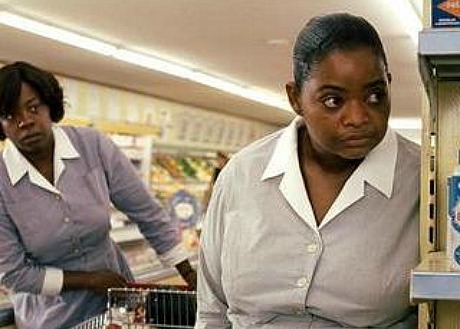
(r.) Octavia Spencer, (l.) Viola Davis in The Help.

Don't Get the Hate
All Adam Sandler comedies tend to be obvious and primitive and aimed at lowbrows, so I don’t see what’s so exceptionally heinous about Jack and Jill. At least it’s addressing a basic fact about sibling relations, which is that some brothers and sisters are an unfortunate fact of life (and in some cases an embarassment) whom you’d prefer to not to keep in touch with, thanks all the same.
I loved my younger sister and younger brother after a fashion, but I didn’t really seek out their company or friendship because they were both fairly undeveloped people, and I would run out of conversational fodder with them fairly quickly.

